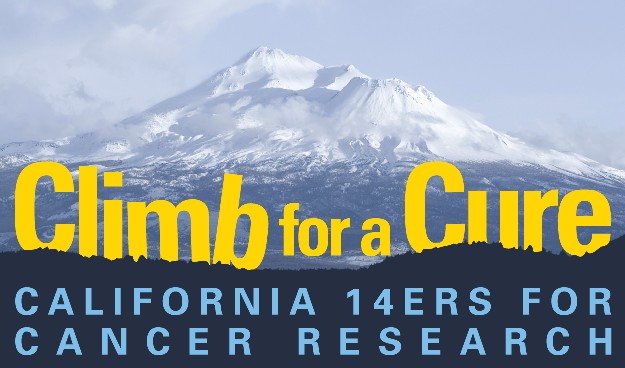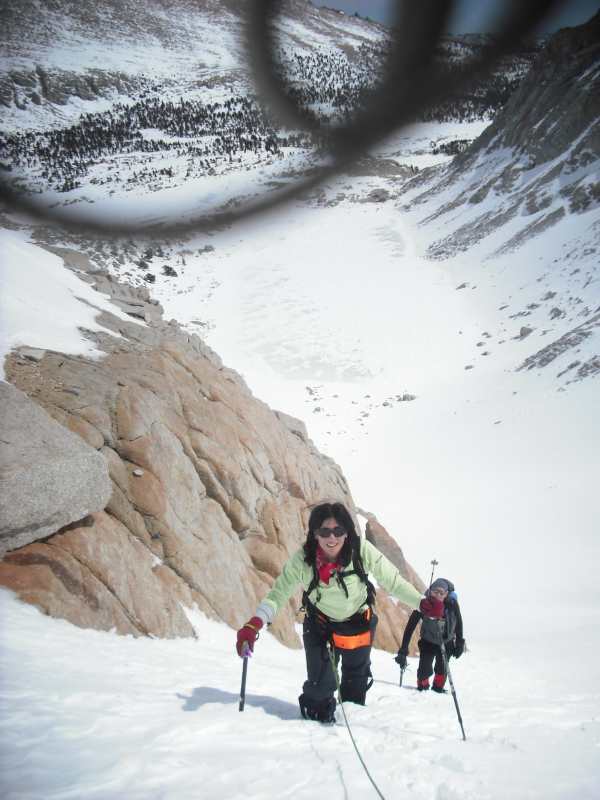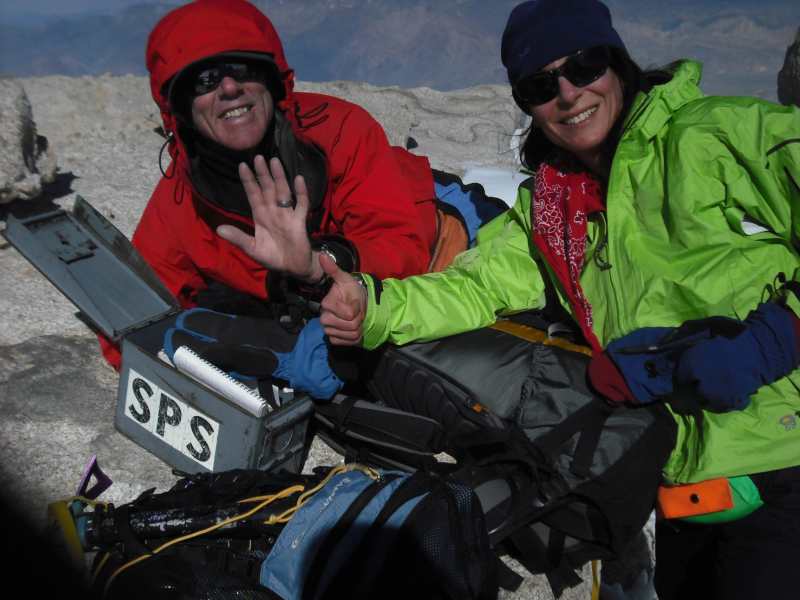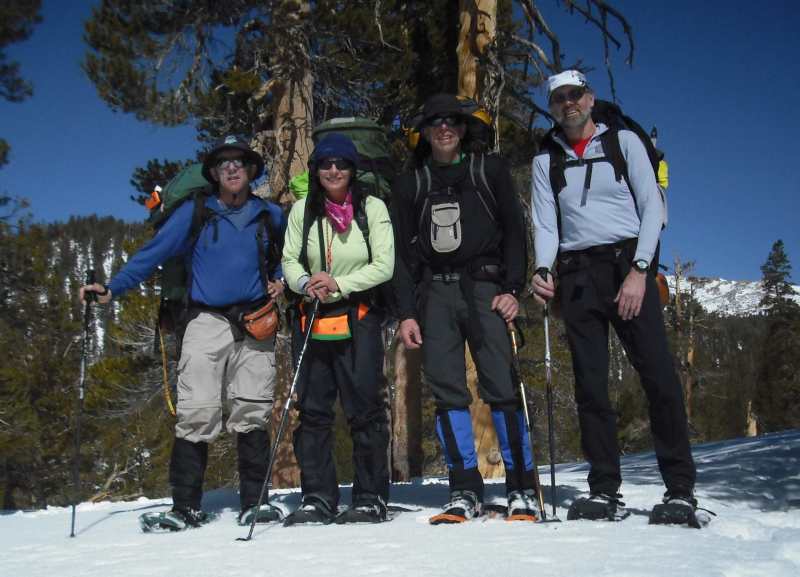
|
Donate Now |
Mt Langley
March 13th - 15th, 2009
Victory snatched from the Jaws of Defeat on Langley.
Those present: Adrian Crane, Deborah Steinberg, Ray Kablanow, Carey Gregg.
Also known as 'The Epic Slog' or 'Victory in the Jaws of Defeat'
Whenever a trip seems on paper that it will be quick and simple, leave it to Adrian to make sure there will be enough challenge in it. We knew from the beginning that this strictly winter-conditions climb, would be less technical yet with a long approach. What we didn't know was that the very length of it would make us most doubtful of success. We knew that in winter we could not drive all the way to the trailhead, but expected to be stopped around the snowline at 8,000ft, three miles from the trailhead. Two days before leaving we discovered that the road to the trailhead was actually closed 12 miles from the trailhead and at 5600' elevation. We scrambled to come up with a solution for those extra miles and decided on bicycles. So now we planned to ride with full backpacks 12 miles uphill ' not an inviting prospect! When we arrived Thursday evening, we camped at the road closure. Fortunately for us, on Friday morning, with bikes laid out and ready to start our long ride, a rancher couple let us through their property with the van. Adrian was actually worried that we were not going to be able to use the bicycles at all, which would have made things too easy. However snow and ice on the road and a lack of functioning 4WD allowed us to reduce our trek by only 5 ' miles and 2200' in elevation gain leaving us with plenty of enjoyable(!) riding. From there we rode our bikes steeply uphill, walking them when necessary through the patches of snow. Carey pulled a kiddie trailer loaded down with 50 pounds of our heavier items, but we all still rode with full packs. It was a slow grind in lowest gear. Eventually we reached a point where we were pushing our bikes more than riding them, so we ditched our bikes for snowshoes, and took off on foot. We were still a good 3 miles from the trailhead. After a couple of miles, Adrian thought we should ditch our snowshoes, since he's rarely needed them beyond 10,000 ft. elevation. Deborah said 'No, if we need them and don't have them we will be up the creek without a paddle' or should that be phrased 'in the snow without snowshoes'! That turned out to be the call of the day, because we ended up on snowshoes most of our trip. Traveling on snowshoes is a bit like hiking in sand. Just as there are many types of sand, there are numerous types of snow, which affects how difficult it will be to trek through it. It is extremely difficult to break trail in heavy wet snow, but cold dry fluffy snow, or, better yet, hard compacted snow is much easier. Over many miles of terrain you are likely to see all types and levels of difficulty. One thing is for sure: Travel by snowshoe is much more tiring than travel on ice with crampons. Crampons grab the ice like cleats on a grassy hill. Since crampons were not an option at this point, we navigated our way towards Langley, and Adrian and Ray took turns breaking trail. We knew the more progress we made today would make it easier the next day. Although not nearly as far as we had hoped, by 5:30 pm we found two large downed trees and set up camp between them giving ourselves space on the logs for our kitchen. Our elevation was 10,200ft. Carey quickly set in to melt snow for water for our dehydrated meals and drinks. Now stopped, we soon got cold and colder still as the temperature dropped with the sun. When we set up Deb's 4-person tent everyone became jealous of Carey's down-filled sleeping pad.
We woke up 5:30 am Saturday morning to frozen hiking boots. In fact anything that did not sleep with us in our sleeping bags overnight was frozen It took us a while to choke down breakfast and attend to business, so we did not set off that morning on our snowshoes until 7 am. The terrain was incredibly beautiful, and we were amazed at all the trees and wildlife present at such high elevation. The tree line was at almost 11,000 ft, and we saw the tracks of rabbit, bear, and coyote crossing our snowshoe path. Deborah disparaged Ray for his slow pace and decided to take over breaking trail until she realized that the reason Ray was moving so slowly is that breaking trail is exhausting and
 slow work. She lasts about 100 yards and spends the next two hours apologizing for her ignorance. Adrian worries that we are not moving at a fast enough pace, so Deborah encourages him to be in the lead instead. Feeling fatigued from the long day before, Carey decides to head back to camp and be support crew. Eventually our group, now numbering three, reaches Lower and Upper Cottonwood Lakes which are eerily beautiful frozen open space. We traded our snowshoes for crampons and laughed that to those watching us on SPOT it would look like we were swimming across the lake, since the satellite photos Google Earth uses are from summer. So late in the day and only just onto crampons, Adrian was sure that we were continuing only to save face and that the summit was out of reach. At the far end of Upper Cottonwood Lake is Old Army Pass, a steep snow slope 500 vertical feet up at a 45 degree angle. Deb, Ray, and Adrian decide to rope up and not look down. For most of the pass we were kicking steps in the ice and ascending slowly but safely. Then we found ourselves in a patch of hard ice where we are hanging on by our crampon spikes and the picks of our ice axes, and we pray that if we slip our companions will have enough grip to keep us from all falling. Deb panics briefly but loudly as she slips. After she freaks out she looks back to find that Adrian and Ray had her securely on a few feet of rope with an ice axe buried to the hilt as a belay.. Her legs are shaking anyway. We reached the top of Old Army Pass at 12 noon. Since, according to the map, Old Army Pass was the most difficult section of our climb, we start to have a feeling that it might be possible to make the summit by 4 pm, which would still leave precious little time to descend the steeper sections safely in
slow work. She lasts about 100 yards and spends the next two hours apologizing for her ignorance. Adrian worries that we are not moving at a fast enough pace, so Deborah encourages him to be in the lead instead. Feeling fatigued from the long day before, Carey decides to head back to camp and be support crew. Eventually our group, now numbering three, reaches Lower and Upper Cottonwood Lakes which are eerily beautiful frozen open space. We traded our snowshoes for crampons and laughed that to those watching us on SPOT it would look like we were swimming across the lake, since the satellite photos Google Earth uses are from summer. So late in the day and only just onto crampons, Adrian was sure that we were continuing only to save face and that the summit was out of reach. At the far end of Upper Cottonwood Lake is Old Army Pass, a steep snow slope 500 vertical feet up at a 45 degree angle. Deb, Ray, and Adrian decide to rope up and not look down. For most of the pass we were kicking steps in the ice and ascending slowly but safely. Then we found ourselves in a patch of hard ice where we are hanging on by our crampon spikes and the picks of our ice axes, and we pray that if we slip our companions will have enough grip to keep us from all falling. Deb panics briefly but loudly as she slips. After she freaks out she looks back to find that Adrian and Ray had her securely on a few feet of rope with an ice axe buried to the hilt as a belay.. Her legs are shaking anyway. We reached the top of Old Army Pass at 12 noon. Since, according to the map, Old Army Pass was the most difficult section of our climb, we start to have a feeling that it might be possible to make the summit by 4 pm, which would still leave precious little time to descend the steeper sections safely in daylight. We are exhausted, but since Deb and Adrian are climbing for City Of Hope, and Ray is climbing for the Howard Training Center we are loathe to give up. Deb is starting to get blisters on the bottom of her feet, but decides she doesn't have the time to stop and fix them. After another rather steep climb we reach 13,000 ft elevation and see fresh tracks in the snow from a herd of mountain goat. Amazed at the idea of wildlife living so high, we then run across fox tracks as well. We traverse across an endless plateau and reach a false summit, only to realize the real summit is another half a mile away. We are exhilarated when we reach the true summit at 3:35 pm and are treated to outstanding views of snow covered mountains on every side. We quickly take photos and video, and sign the log book in memory of Barbara Carnes, Adrian's sister-in-law who died of lung cancer in 2003, and in honor of Crystal Franco who works with Deborah and has battled breast cancer. The last log in the summit book was from January 18, 2009! We put our mementos in the summit box and begin descending. The long high ridge is exposed to the weather and the wind begins to rise Luckily it is not till we are back at the top of Old Army Pass roping up for the descent that the real wind begins to hammer us. We scamper over the edge and into the relative shelter of the gully. Descending the steep snow takes a long time and by the time we make it to the flat wastes of the lake it is dusk. We take a break to eat, take off our sunglasses and retrieve our snowshoes and then find this mornings snowshoe trail before it gets truly dark. Back in the trees we are not entirely sheltered from the wind and it is a cold evening as we pick out our trail toward camp. In the noise of the crunching snowshoe, it is hard to carry on a conversation so we each enjoy our own thoughts and the dark woods and bright snow around us. Our progress is quick because the trail is already broken, and it is easy to follow in our headlamp light. We waste no time during our return trek and we radio ahead to Carey who has hot water and dinner ready when we arrive back at camp at 10:15 pm. By 11:20pm we are asleep in our tents.
daylight. We are exhausted, but since Deb and Adrian are climbing for City Of Hope, and Ray is climbing for the Howard Training Center we are loathe to give up. Deb is starting to get blisters on the bottom of her feet, but decides she doesn't have the time to stop and fix them. After another rather steep climb we reach 13,000 ft elevation and see fresh tracks in the snow from a herd of mountain goat. Amazed at the idea of wildlife living so high, we then run across fox tracks as well. We traverse across an endless plateau and reach a false summit, only to realize the real summit is another half a mile away. We are exhilarated when we reach the true summit at 3:35 pm and are treated to outstanding views of snow covered mountains on every side. We quickly take photos and video, and sign the log book in memory of Barbara Carnes, Adrian's sister-in-law who died of lung cancer in 2003, and in honor of Crystal Franco who works with Deborah and has battled breast cancer. The last log in the summit book was from January 18, 2009! We put our mementos in the summit box and begin descending. The long high ridge is exposed to the weather and the wind begins to rise Luckily it is not till we are back at the top of Old Army Pass roping up for the descent that the real wind begins to hammer us. We scamper over the edge and into the relative shelter of the gully. Descending the steep snow takes a long time and by the time we make it to the flat wastes of the lake it is dusk. We take a break to eat, take off our sunglasses and retrieve our snowshoes and then find this mornings snowshoe trail before it gets truly dark. Back in the trees we are not entirely sheltered from the wind and it is a cold evening as we pick out our trail toward camp. In the noise of the crunching snowshoe, it is hard to carry on a conversation so we each enjoy our own thoughts and the dark woods and bright snow around us. Our progress is quick because the trail is already broken, and it is easy to follow in our headlamp light. We waste no time during our return trek and we radio ahead to Carey who has hot water and dinner ready when we arrive back at camp at 10:15 pm. By 11:20pm we are asleep in our tents.
 Sunday morning we awaken at 7:30 am, and it takes 20 minutes for Deborah to prepare her feet for the day with blister pads and tape. . Adrian thought he was so tired that he couldn't see straight, until he realized it was because he was wearing Carey's glasses. We break camp, and by 10:10am we are back on the trail. We make good progress until we reach our bicycles and realize the kiddie trailer which is storing all our heavy gear has a flat tire. After much discussion about pumps and Schraeder valves we discover the large hole in the tube. Not having a spare for the trailer tire, we decide that we will have to make a 26 inch tube from the bike fit into the 20 inch trailer tire. Miraculously it seems to work, and at 1:30pm we set off on bikes. We reach the van at 2pm and realize that we have seen no other people in 2 ' days! Our navigation during the 33-mile round trip was exclusively by map and compass, and we had no trails or signs to follow. Adrian felt like the suspense of not knowing whether we were going to make it made the success that much more appreciated. At dinner in Lone Pine Deborah and Adrian argue over which climb so far has been the most difficult. We all decide that this trip was definitely up there near the top.
Sunday morning we awaken at 7:30 am, and it takes 20 minutes for Deborah to prepare her feet for the day with blister pads and tape. . Adrian thought he was so tired that he couldn't see straight, until he realized it was because he was wearing Carey's glasses. We break camp, and by 10:10am we are back on the trail. We make good progress until we reach our bicycles and realize the kiddie trailer which is storing all our heavy gear has a flat tire. After much discussion about pumps and Schraeder valves we discover the large hole in the tube. Not having a spare for the trailer tire, we decide that we will have to make a 26 inch tube from the bike fit into the 20 inch trailer tire. Miraculously it seems to work, and at 1:30pm we set off on bikes. We reach the van at 2pm and realize that we have seen no other people in 2 ' days! Our navigation during the 33-mile round trip was exclusively by map and compass, and we had no trails or signs to follow. Adrian felt like the suspense of not knowing whether we were going to make it made the success that much more appreciated. At dinner in Lone Pine Deborah and Adrian argue over which climb so far has been the most difficult. We all decide that this trip was definitely up there near the top.
Adrian Crane and Deborah Steinberg
"Thank you for allowing us to know our climb is making a difference. Your
contribution to City Of Hope
will support important research to help find a
cure for cancer and motivate us to make each summit!